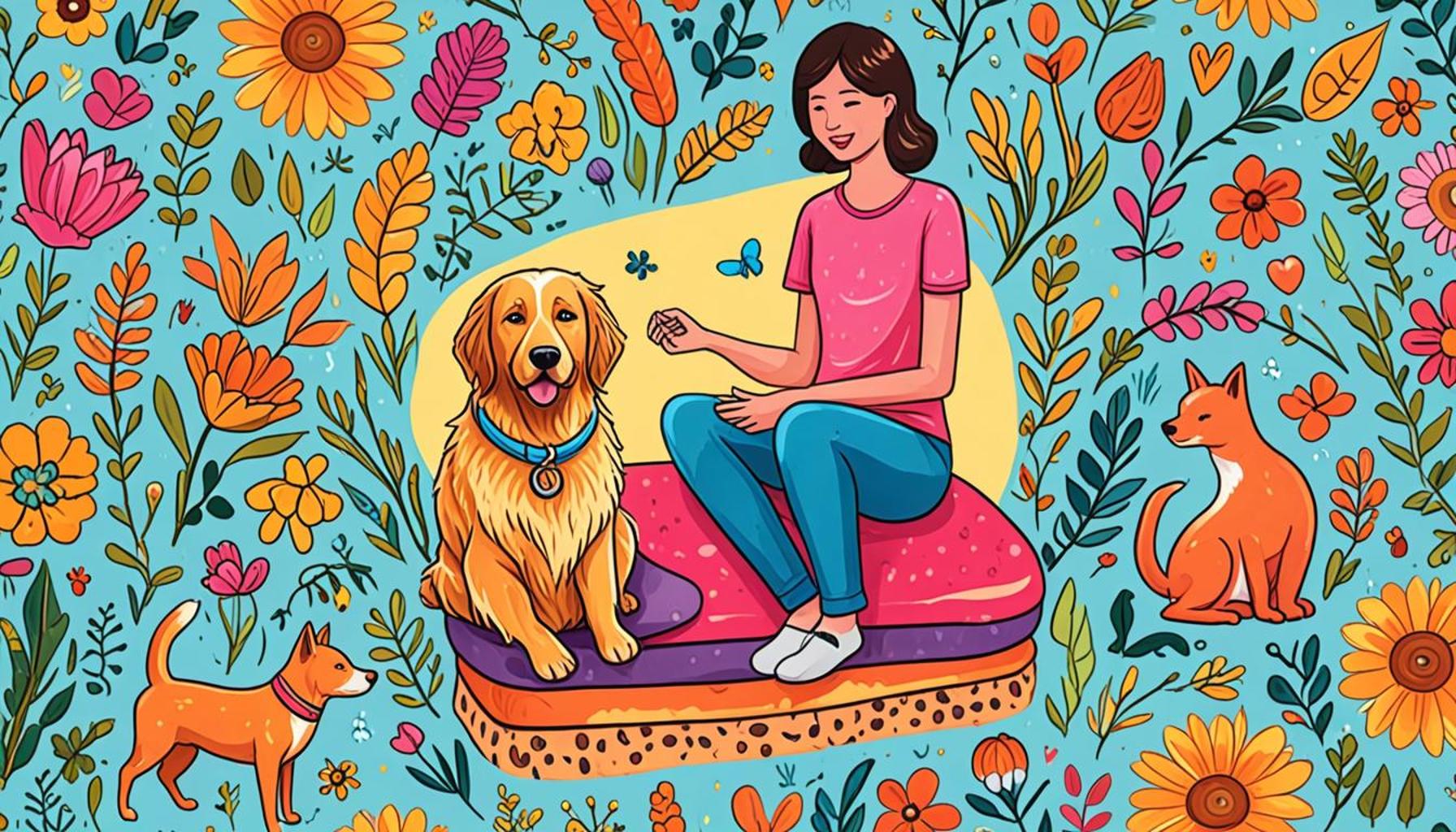Benefits of Animal-Assisted Therapy: Transforming Lives with the Company of Pets

The Profound Connection: Exploring Animal-Assisted Therapy
The bond between humans and animals can have a profound impact, particularly in therapeutic settings. Animal-Assisted Therapy (AAT) leverages this bond, providing emotional and physical support that can transform lives. These therapy sessions often involve trained animals, such as dogs, cats, and even rabbits, who help to foster a healing environment that promotes the well-being of patients.
Patients across various backgrounds have benefited from the presence of these animals. This growth of AAT is driven by the increasing recognition of its therapeutic potential, as more healthcare providers integrate these methods into treatment plans. Key benefits of AAT include:
- Emotional Support: Animals can significantly reduce feelings of loneliness and anxiety. For instance, in a hospital setting, the simple act of petting a dog may release oxytocin in the brain, a hormone associated with bonding and reducing stress. Many patients report feeling more relaxed and less isolated when they interact with therapy animals.
- Physical Benefits: Interacting with pets can aid in rehabilitation and improve mobility. Seniors recovering from surgery or injury often find that engaging with therapy animals motivates them to participate in physical activities, such as walking or stretching, which can speed up their recovery process.
- Social Interaction: Animals can facilitate communication and encourage socialization in group settings. For example, in schools or rehabilitation centers, therapy animals can help break down barriers, making it easier for individuals to engage with one another and share their experiences.
Research indicates that therapy animals can lower blood pressure, reduce stress, and even enhance overall well-being. Studies conducted in various healthcare environments, including hospitals and mental health facilities, demonstrate how time spent with therapy animals correlates with decreased anxiety levels and increased overall satisfaction among patients.
This unique form of therapy is gaining popularity across the United States, transcending traditional therapeutic environments. Hospitals are increasingly featuring AAT programs within their patient care strategies, while schools are introducing therapy animals to help students cope with academic pressures and social challenges.
The growing body of evidence supporting the benefits of AAT has not gone unnoticed. Mental health professionals as well as rehabilitation specialists are now weaving animal interactions into their treatment modalities, recognizing that the companionship of animals extends far beyond mere comfort; it is a powerful tool in the healing process.

As we delve deeper into this topic, the following sections will explore specific ways in which Animal-Assisted Therapy enhances mental health and aids in recovery. From case studies to expert testimonies, we will illuminate how this innovative approach empowers individuals to lead fulfilling lives while emphasizing the extraordinary impact that animal companionship can have on human health and emotional resilience.
LEARN MORE: Click here to discover the importance of early socialization
Unlocking Mental Health: The Role of Animal-Assisted Therapy
As mental health awareness continues to rise, alternative therapies like Animal-Assisted Therapy (AAT) are coming to the forefront, showcasing how the comforting presence of pets can facilitate emotional healing. AAT focuses on the interaction between patients and trained animals, offering not just a momentary distraction but a genuine avenue for emotional expression and growth. The mere presence of a furry companion can open up channels of communication that may otherwise remain sealed shut.
One of the most remarkable aspects of AAT is its versatility; it can be adapted to serve individuals across various demographics, including children facing anxiety, veterans coping with PTSD, and the elderly experiencing loneliness. This diversity highlights the universal appeal of therapy animals, making them an essential component of many therapeutic programs. The following are key ways AAT is known to bolster mental health:
- Reducing Anxiety and Depression: Numerous studies indicate that spending time with therapy animals helps alleviate symptoms of anxiety and depression. The simple act of petting a dog, for instance, can release serotonin, a chemical that contributes to feelings of well-being. Participants in AAT programs often report significant improvement in their mood and emotional state following these interactions.
- Enhancing Coping Skills: Engaging with therapy animals can provide individuals with tangible ways to manage stress. For example, emotional attachments formed with animals can serve as a grounding technique during moments of distress, helping patients develop healthy coping strategies. The presence of a supportive animal can encourage individuals to communicate their feelings more openly.
- Stimulating Motivation: In therapeutic settings, animals can act as powerful motivators for patients to engage in often difficult tasks. In rehabilitation scenarios, patients who are encouraged to interact with animals tend to show higher levels of participation in physical exercises, leading to improved outcomes in their recovery.
The impact of AAT on mental health has been further substantiated through research conducted in various fields, from psychiatric facilities to addiction treatment centers. Reports reveal that clients involved in AAT recorded notable progress in their treatment plans, often demonstrating a renewed sense of purpose and motivation. This increased engagement is attributed to the authentic emotional bonds formed between therapy animals and patients.
Moreover, institutions across the United States are witnessing positive shifts as they integrate AAT into their therapeutic frameworks. Educational settings are also embracing the idea, with therapy animals being introduced to help children navigate academic pressures and enhance their social interactions. This approach not only benefits students but also creates a more humane and empathetic educational atmosphere.
In the following sections, we will delve deeper into specific success stories and research findings that underscore the effectiveness of Animal-Assisted Therapy in promoting emotional resilience and improving overall well-being. We invite you to explore how therapy animals are not just companions but vital partners in the healing journey.
| Category | Details |
|---|---|
| Emotional Support | Animal-assisted therapy can provide unconditional love and companionship, significantly reducing feelings of loneliness and loneliness-related mental health issues. |
| Physical Health Benefits | Interactions with therapy animals are linked to lower blood pressure, decreased levels of stress hormones, and improved overall health, enhancing patients’ recovery. |
| Skill Development | Working with animals helps individuals develop social skills and emotional regulation, which is particularly beneficial for children with autism or other developmental disorders. |
| Improved Quality of Life | Overall, animal-assisted therapy encourages a more active lifestyle, fosters a sense of purpose, and enhances the ability to cope with challenges. |
DISCOVER MORE: Click here to learn how your pet’s dental health impacts their well-being
The Healing Touch: Physical Benefits of Animal-Assisted Therapy
While the mental health advantages of Animal-Assisted Therapy (AAT) are widely recognized, a growing body of evidence suggests that the physical health benefits can be equally transformative. The interaction with therapy animals does not merely provide emotional support; it can also lead to improved physical health outcomes for individuals of all ages. Here are some critical aspects of how AAT can contribute to physical well-being:
- Encouragement of Physical Activity: One of the direct outcomes of engaging with therapy animals, especially dogs, is an increase in physical activity. For individuals with limited mobility or those confronting chronic pain, the presence of a therapy animal can motivate them to partake in low-impact activities, such as walking or playing. Research indicates that those involved in regular interactions with animals see a marked improvement in their overall fitness levels and cardiovascular health.
- Reduction in Pain and Discomfort: Numerous studies suggest that animal interactions can lead to lower levels of reported pain. When patients engage in AAT, the focus shifts from their discomfort to their interactions with the animal, which can create a temporary distraction from pain. This phenomenon is sometimes referred to as the “pet effect,” where the comfort derived from the animal’s presence allows for a significant reduction in pain perception.
- Improvement in Overall Well-Being: Therapy animals have been shown to foster feelings of joy and contentment, which can lead to better physical health through mechanisms like reduced stress levels and improved immune response. The release of oxytocin, a hormone associated with bonding and social connection, is stimulated during positive interactions with animals, contributing to a stronger immune system and overall vitality.
Moreover, a notable presence of AAT in rehabilitation settings highlights the crucial role therapy animals play in recovery processes. Hospitals and clinics across the United States are integrating therapy programs, utilizing animals to assist patients in their healing journey. For instance, stroke and surgery recovery patients often face hurdles related to motivation and emotional stability. In these cases, the companionship of therapy animals serves as a beacon of encouragement, allowing patients to push through their rehabilitation exercises with renewed vigor.
Furthermore, studies in educational and geriatric facilities have demonstrated that therapy animals can improve physical health among target populations. In schools, children are observed to engage in more physical activities and demonstrate better social behavior when therapy animals are present. For the elderly, especially those in nursing or assisted living facilities, therapy animals combat feelings of loneliness and encourage social interactions, which are vital for maintaining mental and physical health.
The success stories stemming from AAT applications offer compelling evidence of its widespread impact. Consider the numerous accounts from families who have witnessed their loved ones thriving through the consistent companionship of therapy animals. Whether it’s a child on the autism spectrum developing social skills or an elderly patient finding joy in daily interactions, the tangible outcomes of AAT are reshaping lives beyond mere emotional comfort.
As we continue to explore the depths of AAT, it is essential to consider the voices and stories of those who have experienced the profound effects of therapy animals in both their physical and emotional realms. Their journeys reflect the undeniable bond that exists between humans and animals, one that serves as a catalyst for transformation and healing in countless lives.
DISCOVER MORE: Click here to learn about fascinating cat personalities
Conclusion: Embracing the Power of Companionship
The impact of Animal-Assisted Therapy (AAT) extends well beyond mere companionship, unveiling a tapestry of physical and emotional benefits that can dramatically improve quality of life. As we have explored, AAT plays a significant role in enhancing mental health while also contributing to improved physical health through increased activity levels, reduced pain perception, and bolstered immune function. From children overcoming social challenges to elderly individuals recapturing joy and connection, the presence of therapy animals consistently yields transformative outcomes.
Moreover, the integration of AAT in various settings, such as hospitals, schools, and rehabilitation facilities, showcases its versatility and effectiveness across diverse populations. As therapy animals facilitate motivation and engagement, they pave the way for healing journeys that are both profound and deeply personal. By recognizing the intertwined nature of emotional and physical well-being, we can appreciate the holistic healing that AAT brings into the lives of those it touches.
As we delve further into the benefits of animal companionship and continue to gather compelling evidence from success stories, it becomes clear that AAT is not just a therapeutic trend but a vital tool for enhancing lives. This growing field beckons further research and understanding, and it challenges us to consider how we might further incorporate the steadfast loyalty and love of animals into our routines. Ultimately, the stories of transformation reveal a powerful truth: with the love of a pet, healing is not just possible—it is within reach.


